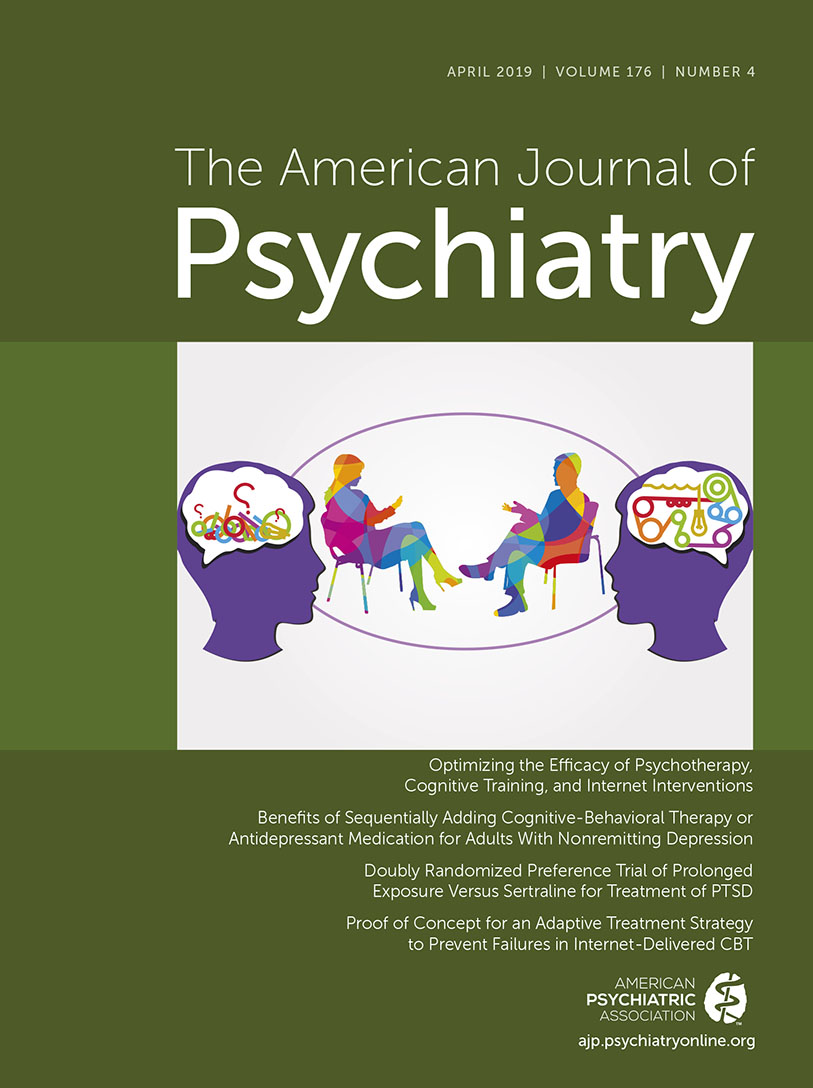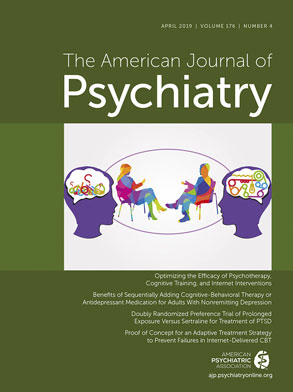How exciting to read the article by Best et al. (
1) in this issue of the
Journal!
As someone who has studied the behavioral and neurological effects of intensive, targeted auditory training in schizophrenia and who confronts the realities of cognitive dysfunction weekly in my clinical work with patients, I find myself having three different responses to this article. My first response, that of a clinical trialist, is admiration: this really is an elegant and well-conducted study. My second response, that of a clinician, is excitement mingled with impatience: more than 25 years ago, Michael Green (
2) challenged us in this very journal to make cognitive remediation a standard treatment for schizophrenia. So why is it taking us so long to get there? And my third response, that of a researcher, includes questions about the perceptual training component of this study and what conclusions we can draw, if any, regarding the usefulness (or nonusefulness) of addressing lower-level sensory processing deficits in schizophrenia spectrum disorders.There is so much to admire in the rigor and elegance of this study. First, the authors set out to tackle a question that has been floating around the field for several years: What form of cognitive remediation will provide the most benefits in terms of real-world functioning? They studied a set of exercises focused heavily on working memory and executive functioning—training to hold information “online,” to categorize information, and to maintain task context—because these are known deficits in schizophrenia. They compared this approach to exercises for lower-level perceptual processing (more details on this later), since deficits in early auditory and visual processing are associated with higher-order impairments in cognition, including social cognition (
3,
4).
Next, the authors recruited participants from three real-world outpatient clinics, and they used the utmost rigor in their randomization, assessment, and outcomes measure methods, maintaining a blind for participants, assessors, and clinicians. Participants completed a highly feasible 6-week program in which eight sessions were performed in the clinic with a therapist. Each session consisted of 40 minutes of exercises plus strategy development discussions and worksheets. This was then followed by 2 weeks of in-home practice alone.
An especially impressive aspect of the study was that the authors compared and contrasted findings in cognition, neurophysiologic indices of perceptual and higher-order prefrontal operations, and functional outcome, with a focus on blinded ratings by community providers. Perhaps most importantly, they included a 3-month posttraining follow-up to determine short-term durability of effects.
Excitement And Impatience
At the 3-month follow-up (although not immediately after the intervention), Best et al. unequivocally found that the executive functioning training, but not the perceptual training condition, resulted in significant gains in cognition, functional competence, and real-world functioning. Participants in executive functioning training also showed an increase in frontal theta power during a visual working memory task at the 3-month follow-up. Interestingly, increases in midline prefrontal theta power during divided attention were documented by Anguera at al. (
5) in a cognitive training study of older adults, and this increase in midline prefrontal theta power correlated with greater cognitive control abilities at the 6-month follow-up. Our group (
6,
7) has also shown a positive relationship between plasticity in prefrontal activation patterns with functional MRI and quality of life measures 6 months after training, correlations not seen immediately after the intervention. Plasticity in prefrontal cognitive control mechanisms may be the driver for delayed “sleeper” effects in behavior.
There are several important implications to these sleeper effects. The first is that research studies need to be designed with adequate follow-up assessments, preferably at 6 and 12 months and even longer. The question of long-term durability of effects and the need for booster sessions is still wide open. The second implication is that clinicians, clients, and family members need to be encouraged to remain patient and engaged with a treatment that has subtle and slow effects. Cognitive remediation will not act like a medication—there will be no sudden and immediate improvement in cognition and functioning. Rather, there will be small, hardly noticeable gains that will accumulate over time, especially when the individual is in an enriched environment that promotes additional vocational and psychosocial successes and the practicing of new cognitive skills (
8).
The clinical and policy implications of the Best et al. findings are clear and add to my own sense of impatience for the field: real-world mental health treatment settings must begin to disseminate cognitive remediation programs as part of their standard of care, and these programs need to be offered to individuals early in the course of illness.
Questions That Remain
Given that the executive functioning training studied by Best et al. is easy to implement and yields clinically meaningful positive results, why not stop here and say our work is done?
Unfortunately, the perceptual training condition in this study does not meet the definition that most of us who do research in targeted perceptual training would use. This limits our ability to compare the results with other studies or to draw definitive conclusions about its usefulness or nonusefulness.
First, the perceptual training condition in the Best et al. study consisted of a loose and imprecise mixture of visual and auditory exercises that could be performed in a range of combinations, orders, and intensities. And yet auditory perceptual training and visual perceptual training have different and sometimes competitive effects (e.g., see reference [
9]), so the type, amount, and order of training, especially in people with perceptual impairments, are important. Learning can be enhanced or impeded, depending on the perceptual pathway being trained and any preexisting strengths or weaknesses in that pathway (
10). In three different cognitive training studies in schizophrenia, we have found evidence of competitive interference between auditory and visual processing, with consequences for verbal learning gains (e.g., see reference
11]).
Second, although details are not provided, the amount of in-home training in the Best et al. study is reported as an average of 5 hours but with a variance of 5.6 hours, indicating an extremely wide range in the total training that occurred for each individual on each exercise and in each condition. And yet Biagianti et al. (
12) have shown that it is an individual’s ability to generate and sustain auditory processing gains after 20 hours of targeted auditory training that predicts generalized cognitive improvement. Thus, insufficient perceptual training of any sort seems to have been the case in the Best et al. study, compounded by the fact that only 18 people actually completed the allocated perceptual intervention compared with 26 who completed the allocated executive functioning intervention. Thus, the perceptual training condition was underdosed and underpowered and may even have created competitive interference effects. So while I find that Best et al. have demonstrated that a brief course of cognitive training of executive functioning provides important benefits, they have not demonstrated that perceptual training, when properly defined and dosed, is of no benefit.
A third issue is worth considering. The two therapists who delivered the intervention and engaged in the strategy coaching were not blind to the study condition. Strategy development is much easier to implement, and much easier to bridge to the real world, for executive functioning compared with perceptual processing. There may have been highly synergistic and favorable interactions between the executive functioning condition, therapist expectancy and coaching, strategy development, and the practice of real-world adaptive behavior in a way that might not have occurred for the perceptual training condition and might have affected outcomes (
13).
What Is Missing?
Certainly, auditory perceptual training is not as much fun as executive functioning training, and it is harder for patients and family members, and indeed most clinicians, to understand why it might be an important treatment target. Given the strong and exciting results reported by Best et al. for their brief executive functioning remediation program, one might reasonably argue that it is time to just get on with it and put perceptual training aside. Perhaps it is time to stop studying an approach that is counterintuitive and hard to implement and simplify the recommendations that we can make to stakeholders and payers.
I suggest that there are several reasons to take pause before we go this route. First, scientific rigor demands that we perform the correct direct contrast between the two cognitive training strategies, each properly defined and dosed, with longer-term follow-ups (e.g., 12 months) to determine the durability of effects. Second, and most important for the future of precision psychiatry, we must investigate interindividual differences in the neural and behavioral responses to these two strategies. Hochberger et al. (
14) have shown that one hour of auditory perceptual training can generate changes in auditory mismatch negativity and that these changes predict who will show cognitive and symptom improvement after 30 hours of training; such findings suggest that in certain individuals, auditory training harnesses mechanisms of short-term neuroplasticity that continuously update predictive models for incoming stimuli in sensory cortex—likely a very different set of mechanisms than those harnessed by executive functioning training, mechanisms that may be very salient for certain biotypes of schizophrenia.
In this vein, it is worth noting the recent study by Medalia et al. (
15), who assessed for the presence of early auditory processing dysfunction prior to cognitive remediation. Those with this dysfunction showed a significant benefit from early auditory processing training on verbal learning outcome measures, and cognitive gains partially mediated the relationship between gains in auditory processing and functional capacity. As the authors conclude, it is important to address basic auditory processing deficits when attempting to remediate higher-order verbal learning impairments in schizophrenia.
Finally, there is a cognitive training component not studied by Best et al.—but that most agree should be an integral part of any clinical offering—and that is social cognition training. Many groups have shown the beneficial effects of adding exercises that train elemental aspects of social cognition (eye gaze detection, facial emotion recognition, etc. [
16]), and there is evidence to suggest that social cognition training is associated with improvements in social information processing and self-ratings of motivated behavior (
17), critical factors for optimal quality of life.
Perhaps we are now poised to embark on true personalized cognitive training regimens for schizophrenia. One can envision a baseline assessment for each individual that determines early auditory and visual processing deficits, executive dysfunction, and social cognitive impairments and then assigns the person to a personalized course of training, depending on his or her unique needs. Some patients may never need to focus on their perceptual processing. Others may find that they can maximize gains when these deficits are addressed and provide a foundation for higher-order improvements.

